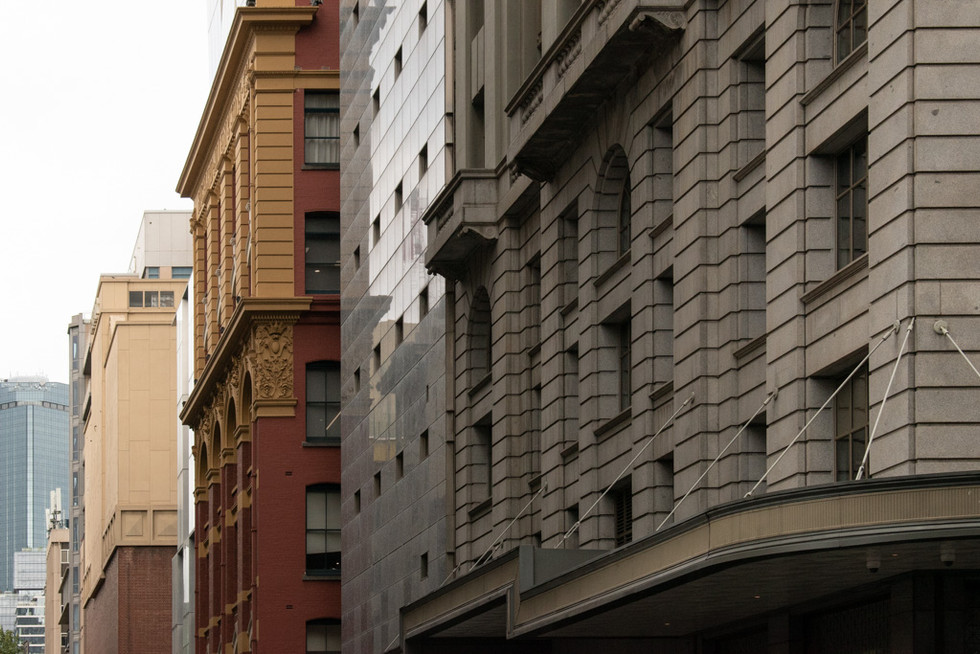Opinion 08: Tactile Architecture
- archigrammelbourne
- May 3, 2023
- 6 min read
Updated: May 22, 2023
By Ivana Dancova
Great architecture pays close attention to how the human body experiences space. When a designer thinks about the body as a whole – full and rich with all its senses – the built form and its many voids has the capacity to elevate a human experience. It engages with the body in a consuming tactile relationship; great architecture is tactile architecture. A designer should pay close attention to and implement three principles, which initiate tactility: a mindful treatment of thresholds and transitions; an understanding of the sense of scale and its impact on the body and mind; and appreciation of materiality as a catalyst for cross-modal experiences. Being a natural conglomerate of activity, function, and service, cities like Melbourne are infused with pockets of tactile architecture. This article records my own musings and observations of the tactile architecture principles from within Flinders Lane – a Melbourne laneway brimming with texture.
Thresholds and Transitions
I often walk through Flinders Lane on my way to work just as the city wakes up from its sleepy daze. At that time of day, the narrow lane is not yet over-crowded with food-seekers and action-doers; instead, it is the buildings, which offer themselves to the act of voyeurism. Some of them lean into me more than others, listening or whispering their stories to me. I walk and observe the palpable passing of time: as economies of scale and production have expanded through human history, so have the buildings grown. On Flinders Lane, the older – smaller - ones fight for their boundaries, holding their own space and stealing it away where they can. The younger ones tower, almost oppressively, over them with modern money and power. Pockets are thus created, tiny voids filled with innovative ingenuity of the human mind: a coffee shop here, a shoe repair shop there, a key & lock-smith another block over. These buildings “in time, grow naturally into being a part of the form and history of their place” (Zumthor, 16). As I pass through, my body absorbs the tactility of the undulating, ever-changing outline of the built form.
Thresholds between these buildings are defined by an assertive encounter of textures creating a beautiful woven tapestry of the city’s life. As I peer into the nooks of the laneway, I notice abrupt boundaries, where materials twist and run into each other unapologetically.

Conscious transition of materiality employs the craftsmanship of detailing. “Details establish the formal rhythm, the building’s finely fractionated scale”; they express the inflection points of the moods between “belonging or separation, tension or lightness, friction, solidity, fragility” (Zumthor, 14).
With or without mindful awareness, we occupy these spaces and ingest these tactile details - the way the materials and scales transition and cross boundaries - and they in turn lead us “to an understanding of the whole of which they are an inherent part.” (Zumthor, 14).
Sense of Scale
Our bodies measure up against our built environment. We sense the scale relative to what we know and understand. The spaces at different scales shelter, invite, dismiss, or reject the body. When inside, they compress or elevate, squeeze or release the body. Tactile architecture uses sense of scale to evoke memorable feelings and create specific experiences.
As the Finnish architect, Juhani Pallasmaa so eloquently noted in his book The Eyes of the Skin:
“I confront the city with my body; my legs measure the length of the arcade and the width of the square; my gaze unconsciously projects my body onto the façade of the cathedral, where it roams over the mouldings and contours, sensing the size of recesses and projections; my body weight meets the mass of the cathedral door; and my hand grasps the door pull as I enter the dark void behind. I experience myself in the city, and the city exists through my embodied experience. The city and my body supplement and define each other. I dwell in the city and the city dwells in me.” (Pallasmaa, 40)
As I experience Flinders Lane, the grain of the building fabric varies consistently. The tall skyscraper looms over me with a power and monumentality of the central business district – the powerhouse of the city. One would assume that all that captured volume must house programs of importance. To me, it signifies the sheer amount of workforce necessary to run a city, making me feel dwarfed in comparison…making me feel like one of the many. Pleasantly across the lane, however, a continuous stream of intimately-scaled offerings open up to me along the way. These spill out into the street with a line of seating arrangements, blurring the hard line of building face, dwell space, and circulation space. Here, the buildings – because of their scale – look one directly in the eye. A narrow side-lane appears and squeezes the body between two towering brick buildings: a quick, invisible shortcut. Another one unfolds whimsically, twisting and leading the body with curiosity and wonderment into a world hidden from view. Using sense of scale, tactile architecture imprints itself onto the body.
Materiality

The laneway explodes with texture. My eye caresses, and at times my hand grazes, the smooth marble, gritty concrete, polished stone, transparent glass, taught fabric, cold steel, reflective tile, massy brick, powdery paint, warm timber, and luscious grass. Materials have much to tell us about the properties of tactile architecture. Tactility, as a responsiveness to stimulation of the sense of touch evokes cross-modal sensory experiences. In one instance it entices the eye and tantalises the body. In another, it repels the eye and isolates the body. Pallasmaa talks about the eye as an extension of the tactile experience:
“Vision reveals what the touch already knows. We could think of the sense of touch as the unconscious of vision. Our eyes stroke distant surfaces, contours and edges, and the unconscious tactile sensation determines the agreeableness or unpleasantness of the experience.” (Pallasmaa, 42).
On my walk, I marvel at the abundance of brick buildings on Flinders Lane. Warmth and history emanate from these hearty red facades as they intermingle with polished grey stone. I notice how my eye has learned from past experiences: I see brick, I understand and anticipate its weight. From its size and the sheer volume needed, my body imagines its assembly through stacking: brick by brick with a human hand and slight imperfections telling of the time, attention, and repetitiveness of the motion. A brick construction speaks of human effort and of craftsmanship.

In pure contrast, I look at the polished stone and my fingertips beg to touch the cold smoothness of the near-frictionless surface. The hardness of stone proclaims an unyielding, impenetrable exterior. As I make my way further down Flinders Lane, a stretch of grey, reflective, shimmery stone facades open up to me. The large size of stone panels implies use of machinery – in both their creation and erection. Unlike brick, polished stone (i.e. marble) speaks of monumentality and suggests societal class. Standing in front of the grey stone building I muse whether peering only at our own reflections isolates us from a deeper community; perhaps these hard, reflective materials are meant to hint at the hidden wealth and powers at play.
Tactile architecture demands honesty and authenticity of material expression. Likewise, it is a delight when a material is manipulated to present in an unexpected way, which further exaggerates its natural inherent qualities: for example a floating (weightless) brick. But it is important to differentiate that from the material pretending to be something it is not: for example brick slips. If we are striving only to achieve the aesthetical properties of an element without using the real material in its full shape and form, our bodies will know. The eye might be momentarily fooled but the illusion is rapidly dissolved at present contact with the substitution.
Every time I walk along Flinders Lane in that pensive hour, just as the imaginary world slips into the real one, I am reminded of the power of physical space. I contemplate how architecture records the passing of human time through the grain of the city. I observe how it reflects our stories back to us through rich layering of scale and materiality. And through it all, I am repeatedly confronted with how tactile it is. Designing with tactility means paying close attention to how we experience our built environment and then further enhancing both the environment and the experience with detailing and craftsmanship. Because after all, architecture is mostly about people.

-
Citation:
Pallasmaa, Juhani. The Eyes of the Skin. Chichester: Wiley, 2007.
Schaik, L. V. (2008). Spatial intelligence: New futures for architecture. John Wiley & Sons.
Spence, C. Senses of place: architectural design for the multisensory mind. Cogn. Research 5, 46 (2020). https://doi.org/10.1186/s41235-020-00243-4
Zumthor, Peter. Thinking Architecture. Basel: Birkhäuser, 2017.
-
Image credit:
Ivana Dancova





























Comments